|
Chattanooga, a Virtual Tour Lookout Mountain Page3 |
||
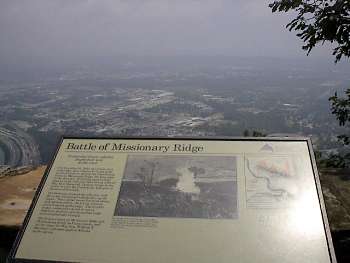 |
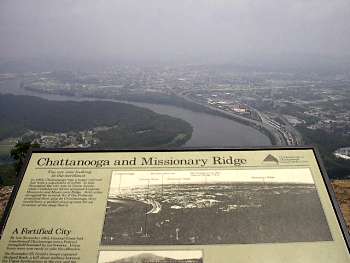 |
|
|
(7-01)
Battle of Missionary Ridge. Site Marker: Undaunted Union infantry
fought their way to the crest. On November 25, 1863, the Union army under
Maj. Gen. Ulysses S. Grant made its final moves to destroy the Confederate
forces on Missionary Ridge, the long ridge in the distance. Following unsuccessful
attacks on the left and right, Grant ordered Maj. Gen. George H. Thomas'
troops in the center to seize the Confederate rifle-pits at the base of the
ridge. The Federals stormed the rifle-pits, and drove the retreating
Confederates up the slopes. Then, under heavy fire from above, and without
orders, the Union infantry pushed ahead up the ridge. The Confederates,
outnumbered and in a poor defensive position, abandoned the ridge and
retreated into Georgia. The Union victory on Missionary Ridge left
Chattanooga firmly in Union hands, and set the state for Maj. Gen. William
T. Sherman's advance against Atlanta in the spring |
(7-01) Chattanooga and
Missionary Ridge. Site Marker: You are now looking to the
northwest. In 1863, Chattanooga was a major railroad hub with a population
of 2,500. In late November the city was in Union hands, while Confederate
forces occupied Lookout Mountain and Missionary Ridge. Both sides
struggled for control, for if the Federals cemented their grip on
Chattanooga, they would have a perfect staging area for an invasion of the
deep south. A Fortified City: By late November 1863, General Grant
had transformed Chattanooga into a Federal stronghold bounded by
earthworks. Union forces were now ready to take the offensive. On November
23, Grant's troops captured Orchard Knob, a hill about midway between the
Union fortifications in the city and the Confederate lines on Missionary
Ridge. On the following two days, the Federals pushed the Confederates
from Lookout Mountain and won a decisive victory on Missionary Ridge |
|
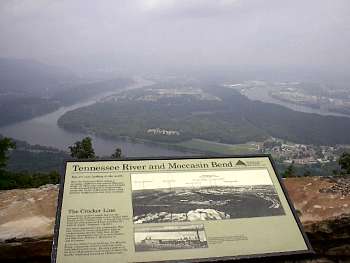 |
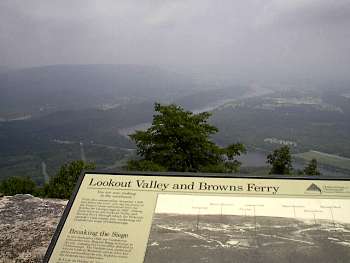 |
|
|
(7-01) Tennessee River and
Moccasin Bend. Site
Marker: Here the Tennessee River makes a sweeping, clockwise loop around
Moccasin Bend. In 1863, vital supplies were brought to the besieged Federals
in Chattanooga across the "neck" of Moccasin Bend, using pontoon
bridges at the two river crossings. The Cracker Line: Union
forces opened a supply line into the besieged city of Chattanooga in late
October 1863. Known as the "Cracker Line," it brought the weary
Federals ammunition and food, including the soldiers' staple -
"hardtack" crackers. The newly appointed Union commander, Maj.
Gen. Ulysses S. Grant, prepared to fight as reinforcements arrived. Maj.
Gen. Joseph Hooker's detachment arrived in early October, and Maj. Gen.
William T. Sherman's in mid-November. In the face of this Union build-up,
Gen. Braxton Bragg, commander of the Confederate army, committed a costly
error. He sent a portion of his army off to attack Union troops at
Knoxville, thereby weakening his grip on Chattanooga |
(7-01) Lookout
Valley and Browns Ferry. Site Marker: You are now looking to the
northwest. From this commanding viewpoint 1,300 feet above the river, you
can see many of the historic areas associated with the Battles for
Chattanooga in 1863. Among these features are Lookout Valley and Browns
Ferry through which the Federals opened a vital supply line, weakening the
Confederate siege of Chattanooga. Breaking the Siege: In late
September 1863, the Confederate army under Gen. Braxton Bragg laid siege to
the city, trapping the Union army defeated at Chickamauga. The Confederates,
positioned here on Lookout Mountain and at other key points surrounding the
city, hoped to starve the Federals into submission. At 3 a.m. on October 27,
Union soldiers cast off from Chattanooga in pontoon boats and floated
secretly down the river. At Browns Ferry they landed and routed the
Confederate pickets. The following day they linked up with Maj. Gen. Joseph
Hooker's Union forces who were moving up Lookout Valley to relieve the city.
A Union supply line was thus opened, and the Confederate strangle-hold on
the city was broken |
|
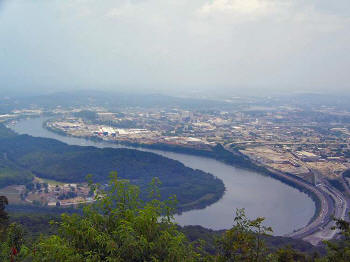 |
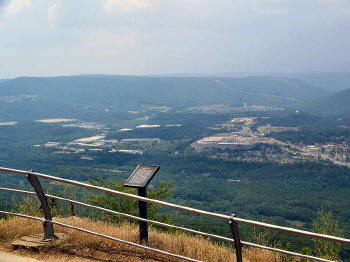 |
|
|
(6-2011)
Enlarge
Moccasin Bend |
(6-2011)
Enlarge
Lookout Valley. Site Marker: You are
looking across Lookout Valley and the flat-topped ridges of the Cumberland
Plateau. The morning of November 24, Union Gen. Hooker's troops crossed
Lookout Creek opposite the present railroad yard in the valley. Then, in a
long column, they climbed the mountain to the base of the cliff to your
left. This wall blocked any further advance to the mountaintop. Facing
north, to your right, the line next moved forward along the slope to
attack the lightly-held Confederate defenses. The advance cleared the
creek bank of Confederate pickets. More Union soldiers crossed to join the
attack, the total attacking force reaching 8000. Walthall's brigade was
driven back around Point Lookout, losing 900 of 1500 men - and the battle! |